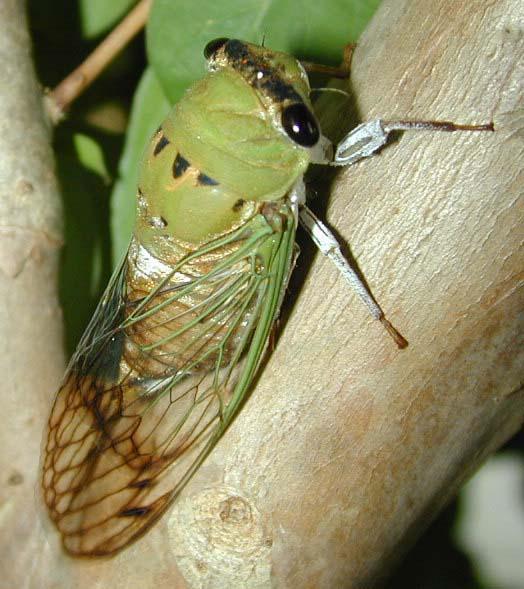Neotibicen superbus (Fitch, 1855) aka Superb Dog-Day Cicada.

Photo by Sloan Childers.
See all Neotibicen superbus images & information on cicadamania.com.
Song type: Call
Source: ©Insect Singers.
Video Playlist
Playlists contain multiple videos found on YouTube.
Name, Location and Description
- Cicada Name: Neotibicen superbus (Fitch, 1855)
- Short Name: N. superbus
- Common Name: Superb Dog-Day Cicada
- Synonym/Former Name: Tibicen superbus
- When: June-August. Peak in July.
- Where it is found: AR, KS, LA, MO, NM, OK, TX
- Maps: Biogeography of the Cicadas (Hemiptera: Cicadidae) of North America, North of Mexico [PDF]
- Description: Green with black mask and yellow arches on back.
- Eye Color: black
- Pronotal Collar Color: green
- Identification: Bug Guide
- Identification: iNaturalist
- Taxonomic Information: Integrated Taxonomic Information System
- Song: Cicada Central
Classification:
Family: Cicadidae
Subfamily: Cicadinae
Tribe: Cryptotympanini
Subtribe: Cryptotympanina
Genus: Neotibicen
Species: Neotibicen superbus (Fitch, 1855)
List of sources
- Full Binomial Names: ITIS.gov
- Common names: BugGuide.net; The Songs of Insects by Lang Elliott and Wil Herschberger; personal memory.
- Locations: Biogeography of the Cicadas (Hemiptera: Cicadidae) of North America, North of Mexico by Allen F. Sanborn and Polly K. Phillips.
- Descriptions, Colors: personal observations from specimens or photos from many sources. Descriptions are not perfect, but may be helpful.
Notes:
- Some descriptions are based on aged specimens which have lost some or a lot of their color.
4 replies on “Neotibicen superbus (Fitch, 1855) aka Superb Dog-Day Cicada”
if i have videos or pictures of superb dog-day cicadas where can i submit them?
When they first come out of their shell, how long until they are ready to fly away? I have one who just came out, and I don’t want to keep him too long.
Thanks!
N Superbus are the type we have every year in Central and South Texas. Seems like their song is distinct from other Cicadas. I’ve loved these insects my whole life. Beautiful to see and hear. I catch them emerging in the evening and place them on the porch pot plants to watch them emerge. In the past couple of years, I have noticed an increase of tree or Carpenter ants. They forage at night apparently. They are vicious on the emerging Cicadas as they are still in their exoskeleton shell. Have any studies on this ever been done?
Neat!